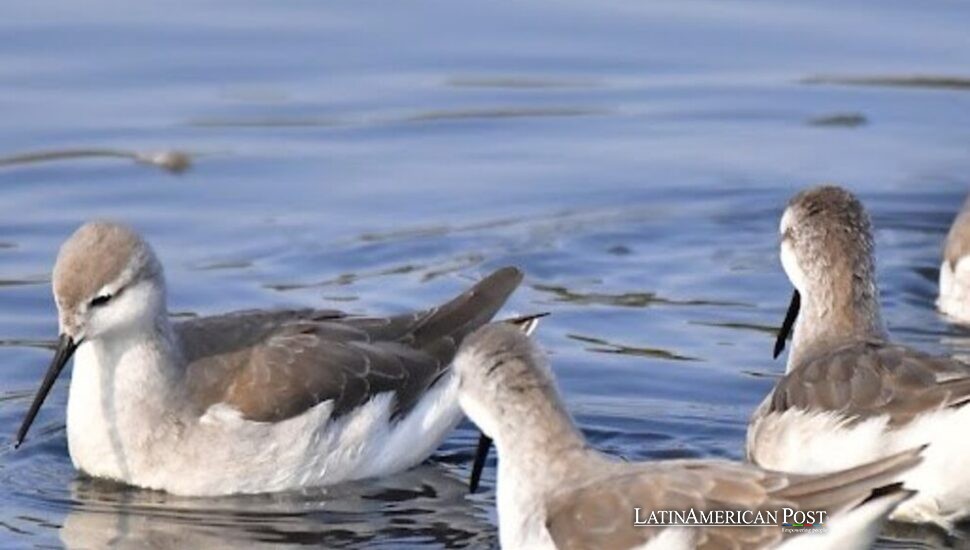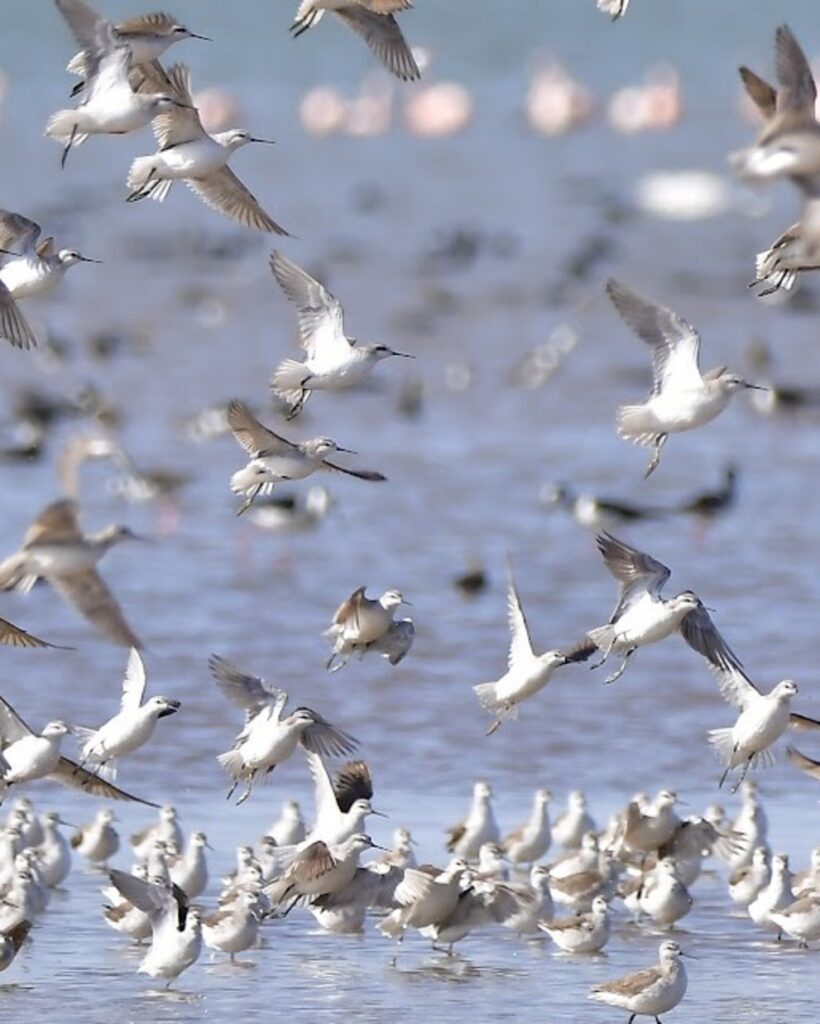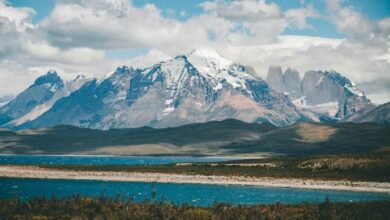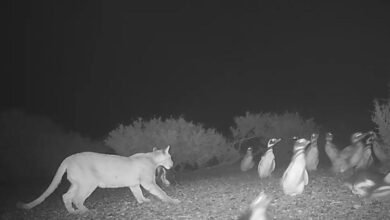Argentina to California Phalaropes Stitch Continents as Lakes Vanish

Each summer at Mono Lake, Wilson’s phalaropes double their weight on clouds of alkali flies. Then, almost invisibly, they arc six thousand miles to Argentina’s Laguna Mar Chiquita—linking two distant communities now bound together by a fragile bird and vanishing waters.
Where a murmuration becomes a bridge
At first light, Mono Lake seems to breathe. Thousands of Wilson’s phalaropes bank and fold in the sky, turning the horizon into a murmuration that whispers like canvas in the wind. When they swoop low, the synchronized whoosh of wings sweeps across the water and the silence feels holy.
These small, needle-billed sandpipers treat the lake as a staging ground. For weeks in July, they gorge on alkali fly larvae and brine shrimp until they wobble with fat, ready to launch south. Then they depart in waves, tracing an ancient aerial path to Laguna Mar Chiquita in Argentina.
The flight carries more than feathers. It has braided Mono Lake and Mar Chiquita into one conversation. What began as shared bird counts between biologists has grown into something unexpected—student exchanges, joint murals, bilingual festival songs, even T-shirts joking about phalaropes’ habit of spinning on the water to stir food. “The bird is what brought us together,” said Yessenia Martínez, a Lee Vining High School graduate who traveled to Argentina and returned home having changed her major to zoology. What pulled her was not just science, but the delicacy and determination of a bird now standing in for all of the world’s imperiled salt lakes.
Lakes on the edge of thirst
The phalaropes’ hemispheric commute doubles as a map of risk. Across the Americas, saline lakes are shrinking—victims of diversion, drought, and neglect. Utah’s Great Salt Lake fell to record lows in 2022 before snow revived it briefly. Oregon’s Lake Abert blinks in and out of existence, pushing starving birds farther south. California’s inland sea carries scars of over-extraction.
Mono Lake itself nearly collapsed after Los Angeles siphoned away its feeder creeks, exposing its famous tufa towers. A 1994 ruling forced cuts, but the lake still teeters. Every drop lost shrinks the fragile shallows where shrimp and flies thrive—and where phalaropes fatten before their six-thousand-mile leap.
“They can’t survive without this habitat,” said ornithologist Ryan Carle, science director at Oikonos Ecosystem Knowledge, who has spent summers counting birds at Mono. This year he estimated a peak of 18,000—a hopeful number compared to recent lows, but still far below the abundance older residents recall.
Carle and colleagues have petitioned to list the phalarope under the Endangered Species Act, dubbing them the “polar bears of salt lakes” because their survival so clearly mirrors the health of the waters they depend on. The equation is blunt: fewer flies and shrimp mean fewer calories, fewer miles, fewer returns. Every conserved gallon, every inch of shoreline, becomes a vote for their comeback.
A classroom stretched across a continent
For students, the phalarope has become both syllabus and passport. California teens have traveled to Argentina’s Mar Chiquita to see flamingos alongside the gray-white sandpipers. Argentine students have flown north to watch flocks rise over Sierra snowfields and dip their hands into Mono’s briny shallows.
Artists painted twin murals at both lakes, each showing the same bird in flight across hemispheres. “We started talking about birds,” Martínez recalled, “but we were also talking about home.” That shared sense of home has practical weight. In 2022, the creation of Mar Chiquita National Park was celebrated with phalarope murals and festivals; a year later, Argentine artist Franco “Vato” Cervato Cozza came north to paint sister images in Lee Vining.
Meanwhile, scientists launched the International Phalarope Working Group to knit together research from Canada, California, and Argentina. Data flows both ways now: shared survey methods, migratory maps, and joint strategies that follow birds through drought, snow, and shifting shorelines. What might have stayed a quiet ecological study has become a story young people step into—a costume contest with felted feathers, a bilingual anthem sung on guitar, classrooms where “what is a saline lake?” becomes “what must we do to save one?”

Following a needle-beaked arrow south
By day, a phalarope looks almost whimsical, spinning in neat circles to stir food from below. By night, it transforms into an arrow. Under the moon, researchers slip nets over the birds, glue tiny transmitters to their backs, and release them into the dark.
On a lab screen, the points begin to move: across Mexico, tracing the Andes, over Ecuador and Bolivia. Some alight at high lagoons where thin air and salt flats cradle them. In September, waves descend to Argentina’s Mar Chiquita, the hemisphere’s largest salt lake, where they wheel beside pink flamingos.
Inside those glowing dots are lives: parents that nested months earlier on Canadian prairies, females who shed their breeding colors for plain gray, individuals so fat with Mono Lake calories they barely lift off—only to slim again over the Andes. It is a procession both precise and fragile. One broken lake may be absorbed by another, but break enough links and the chain snaps. Their power is their network. That is also their weakness.
Still, they have carved space for people to imagine differently. A second-grade class in Lee Vining chanting falaropo tricolor. Argentine teenagers watching Mono’s tufa towers glow at dusk. A scientist strumming a song to a laughing crowd. And Martínez, head down in her zoology program, determined to return to the bird that rewrote her path.
Also Read: Colombian Survivor of the Warsaw Ghetto Built A Century of Renewal
“They’re just a magical bird,” Carle said. “They have a lot of personality.” Magic cannot refill a lake. But wonder can turn into will. With every circle on the water and every mile of sky stitched between California and Argentina, the phalaropes remind us: the line between continents is only the route they share.





